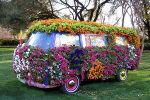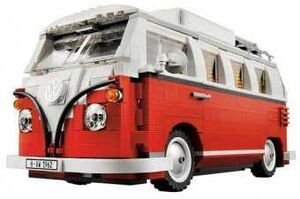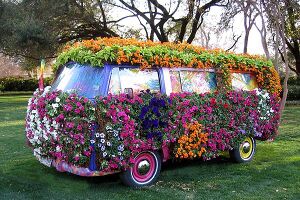Camper van
The camper van, which takes its name from famous pianist Camper Van Beethoven, is a popular type of vehicle, best exemplified by the Volkswagen Type 2 Camper Van as manufactured from about 1949 to 2013 in various guises.
Some camper vans are converted from the VW Kombi, which stands for Kombination von Metallrost und Benzin. In this way, a perfectly acceptable seven-seater minibus becomes a camper trimmed with rotting veneered plywood.
They catch fire[edit]
The worldwide Green campaign to ban useful fuels from the roads by 2020, driven by activists who drive camper vans, has resulted in the addition of ethanol to petrol to almost drinkable levels. The ethanol causes the fuel pipes to crack and spray petrol over the ignition leads. At that point, these eco-gadflies are literally "hoist upon their own environmentally correct petards," as Shakespeare would have put it, at least if he had listened to talk radio more often.
When (not if) a camper van catches fire, it is important to remember that the engine is in the rear. Firefighters often waste valuable time trying to open the front latch, only to find the boot, whose contents catch fire much less often than the engine does. The engine is inside the lower flap at the back end.
The hippies who own camper vans experience comparable consternation when they open the rear hatch to load their suitcases and wonder what the hell that greasy, noisy, whirring thing with the fan belts is doing there.
They don't go very fast[edit]
A safe rate of crawl is achieved by use of a 50-horsepower, 4-cylinder lawnmower engine. Invented by Porsche for the Nazi Volks Wagen in the 1930's, these use state-of-the-art materials like magnesium and aluminium in the engine. (See the preceding discussion of engine fires.) At first, they avoided using suitable metal for the bearings too. Insertion of full-size engines is problematic, because the van's aerodynamics and wobbly tyres would make for a harrowing ride except on Europe's rare straight-away.
Some owners try to boost performance by installing flat engines taken from other vehicles. A favourite is the Scooby, where a large dog is put in the back. This dog goes faster than a lawnmower. This is typically done by the owner of the theme park in a desperate attempt to pull the punters when challenged by a transnational film company 'resort' down the road.
They don't stop very fast[edit]
When new, the brakes can take the camper van from 60 to 0 in fifteen seconds, which is only half as fast as it took to attain 60 in the first place. However, once a bit of air gets into the brake lines, the brake pedal acquires a "vintage" feel and matches the softness of the accelerator response. Were they to work better, the Westphalia plywood table might take flight and injure passengers, as they are stored in the rear approximately at head-height.
They guzzle petrol[edit]
A motorist who has just bought a Ferrari and feels a bit miffed at the fuel consumption can take consolation by looking at the guy in the camper van. He is burning about the same amount of fuel and getting a different kind of fun, and chiefly when the motor is off. At least if he floors the accelerator, he will find it hard to immediately end up in the local duck pond.
He will enter the duck pond very slowly while otherwise occupied in the back when the handbrake lets go when a foot hits it in the middle of the dashboard.
The headlights are crap[edit]
Yes, even after you replace them with halogens. All the electricity is generated on the other end, and about half of it gives up during its trip to the front of the van.
Some of the electricity is used to make sparks. Some of the sparks are distributed to the spark plugs at about the right time. The other sparks are mixed with petrol in quiet corners at the back.
Maintenance is a bitch[edit]
Any really deep pothole is able to crack the engine block. At that point, you simply remove 4 bolts — No, it's about eight, and a load of wires, cables, pipes and other crap. It is equally cumbersome to perform other maintenance that should not require removal of the engine block. Because it does.
You can take the engine out in about a day and put it back the next day. Then do it again to find good homes for the pile of spare parts left behind the first time you reassemble the van. Set aside two entire weekends to change an obscure part (a fuse, perhaps) buried down inside the engine.
They are air-cooled[edit]
Also oil- and petrol-cooled: The evaporating petrol cools down the air going in, and the hot oil pours out on the road. The way the engine is cooled is that you stop and add cold oil every few miles. You don't need water except for the screen washer, which you need to pump up. The engine also cools during the intervals that the camper van experiences vapor lock and sits on the shoulder of the highway.
The Brazilian model is water-cooled because Internal Combustion is the least hot thing that happens in a camper van in Brazil.
They are unreliable[edit]
If you imagine you will use your new camper van like a modern car, based on its cute name and shiny paint job, you will be surprised when it breaks down as soon as you drive off the garage forecourt. It needs constant love and care, time and attention, annoyance, frustration, screaming rage and depression to keep one on the road. Deep pockets help for those little jobs like engine replacement in case you forget to pour the oil in to cool it down after a trip to the shops.
They make them in Brazil[edit]
Briefly in 2013, they were about to stop making them in Brazil, having decided they were now too unsafe even for death-wish South Americans. At the last moment, however, the government decided that camper vans were not cars, so it did not matter if the occupants died in a tangled mess without a slap in a face from an air bag. Regulators classified them as a mobile chicken house, dog house, or storage shed, in the latter case citing their usefulness at holding spare camper-van parts.
Subsequent to this reprieve by the authorities, VW discontinued production anyway, in keeping with its Zero Emissions goal, which it will achieve by making no vehicles at all by 2020.
Storage[edit]
Camper vans are better stored on an asphalt surface than a concrete surface, since it better conceals the perennial leakage of cooling oil. They can also be stored in mud up to the axle to discourage theft.
See also[edit]

|
Recreational vehicles "Keep on trucking!"
|
| Camper van • SUV • Truck • White van |

